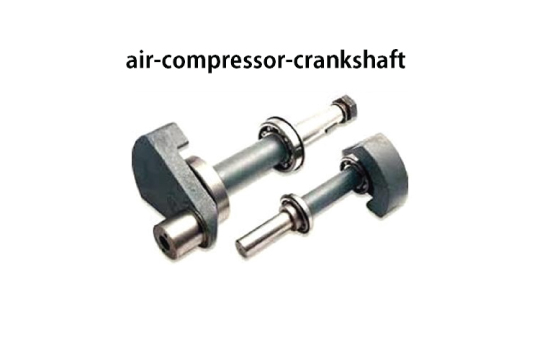-
Call
-
Whatsapp
9825014048
-
Location


Piston Compressor Crankshaft
Piston Compressor Crankshaft
Piston compressors, commonly known as reciprocating compressors, are essential machines in various industries, acting as workhorses for feeding compressed air. At the heart of these compressors is a unique component called the crankshaft, which is available. In this comprehensive guide, we'll explore the world of piston compressor crankshafts, their function, design, materials, and maintenance and their vital role in reliable compressed air delivery.
Using a reciprocating piston to compress air, a piston compressor is a positive displacement compressor. These devices are widely used in the manufacturing, construction, and automotive industries for various applications, such as ventilation for equipment, transport air, and compressed air for industrial applications.
Functions of the Crankshaft in a Piston Compressor
The Crankshaft in a Piston Compressor Performs Several Essential Functions:
- Energy Conversion: The crankshaft's main function is to convert the compressor motor or engine rotational motion into a reciprocating motion. This reciprocating motion drives the pistons into the cylinder, compressing and expanding the air.
- Piston movement: As the crankshaft rotates, it transmits this movement to the connecting rods attached to the pistons. The parallel motion of the piston in the cylinder creates the pressure gradients necessary for compression and expansion.
- Timing: The crankshaft plays an essential role in the input and output timing of the compressor. This allows air to be drawn into the tubes, compressed and expelled more efficiently.
- Balance and smooth operation: A properly designed and balanced crankshaft helps the compressor operate smoothly and vibration-free. This is especially important where accuracy and precision are required.
Types of Crankshaft Design
Crankshafts for piston compressors come in various shapes to suit different applications. Typical features include:
- Single crankshaft: On small portable piston compressors, all pistons are usually driven by a single crankshaft. This system is simple and cost-effective.
- Multiple crankshafts: Large industrial piston compressors may use multiple crankshafts to drive different pistons. This system provides greater control over the compressed air and can handle larger amounts.
- Crosshead crankshaft: Crosshead crankshafts are commonly used on large, high-pressure piston compressors. A crosshead assembly is included that separates the piston from the crankshaft, reducing wear and enabling high-pressure compression.
- Offset crankshaft: Offset crankshafts are used on some compressors to reduce external forces on the piston and cylinder walls. This design can extend the life of the compressor components.
Materials for Crankshaft Construction
The selection of crankshaft materials depends on factors such as compressor size, intended use, and operating conditions. Common uses include:
- Carbon steel: Carbon steel crankshafts are economical and suitable for small compressors with moderate operating pressure speeds.
- Alloy Steel: Alloy steel crankshafts provide improved strength and durability, making them suitable for high-pressure applications of large compressors.
- Cast Iron: Cast iron crankshafts are known for their excellent vibration-damping characteristics. It is commonly used in heavy industrial compressors.
- Forged Steel: Forged steel crankshafts provide exceptional strength and are commonly used in large-duty and heavy-duty compressors.
Repair and Maintenance
Maintenance of the crankshaft is essential for the reliable operation of the piston compressor.
- Lubrication: Proper lubrication of the crankshaft and associated components is essential to reduce friction and wear. Lubrication schedules should be diligently followed.
- Alignment: Proper alignment of the crankshaft and associated components, including the piston and cylinder, is essential to prevent damage and excessive vibration.
- Inspection: Inspection is done regularly for signs of wear, damage, or abnormalities.
- Balance: The balance of the crankshaft in high-performance compressors is important to ensure proper operation and reduce vibration.
The crankshaft is undoubtedly the heart of a piston compressor, responsible for converting rotational motion into reciprocating motion and driving the compression system. Its design, materials, and maintenance play important roles in ensuring piston compressors are efficient and reliable in various industries.
As technology advances, crankshaft designs and materials continue to improve, improving performance, reducing maintenance requirements, and increasing compressor performance if we understand the importance of the crankshaft and invest in its proper maintenance in 2012, allowing businesses to harness the power of piston compressors for a wide range of applications.


FAQ

Frequently Ask Questions
The crankshaft in a piston compressor converts the linear motion of the piston into rotational motion. It's a vital component that drives the compressor's operation by transferring power from the piston to the compressor's drive mechanism.
Signs of a faulty crankshaft in a piston compressor may include excessive vibration during operation, knocking or grinding noises, irregular compressor performance, or visible damage such as cracks or bends in the crankshaft. Regular maintenance and inspection can help identify issues early.
Piston compressor crankshafts are commonly made from high-strength alloy steel or cast iron. These materials offer the necessary durability and resistance to the stresses of rotational motion and compression cycles within the compressor. The choice of material may vary depending on factors such as compressor size, operating conditions, and desired longevity.

